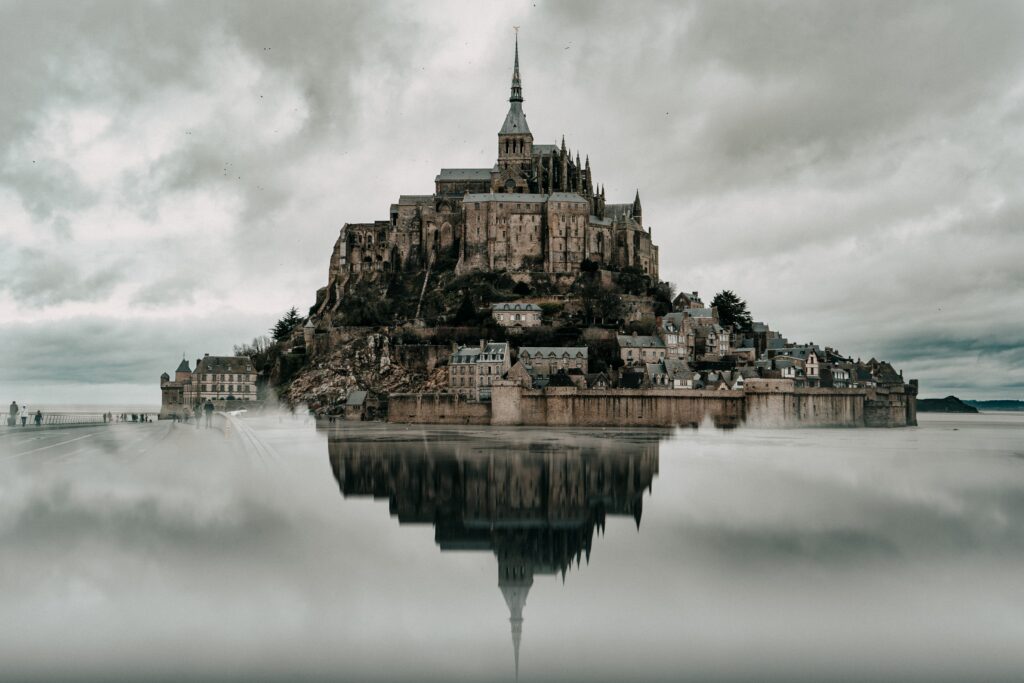
Introducing Mont Saint Michel: A Jewel of Medieval Architecture
THE Mont Saint Michel, also known as "The Wonder of the West," is one of Europe's most fascinating and impressive sites. Located in the Normandy region of northwestern France, this incredible stone enclave rises majestically on a rocky islet in the middle of the Couesnon River estuary. The magnificent medieval architecture of Mont Saint Michel is a vivid testament to the skill and ingenuity of medieval builders.
The site consists of an impressive Gothic abbey atop the islet, surrounded by narrow cobblestone streets and stone houses that make up the village below. Mont Saint Michel's rich and intriguing history dates back to the early 8th century.
According to legend, the Archangel Michael appeared to Aubert, the bishop of Avranches, ordering him to build a church atop this small rocky island. Over the centuries, this modest church evolved into the grand abbey we see today.

Mont Saint Michel during the Middle Ages: A Strategically Important Fortress
During the Middle Ages, Mont Saint Michel played a crucial role in the region's defense and military strategy. Located on a rocky island in northwestern France, near the borders with Normandy and Brittany, its unique location provided a significant tactical advantage.
Its elevated position offered a panoramic view of the entire surrounding area, allowing defenders to monitor land and sea routes. Furthermore, Mont Saint Michel was a prominent landmark for vessels navigating the English Channel.
Its strategic location allowed for the control and taxation of the flow of goods and passengers passing through the region. As a result, the mountain became an important commercial center during the Middle Ages, contributing to its economic prosperity.
The Architectural Evolution of Mont Saint Michel: A Reflection of the Styles and Influences of the Period
Over the centuries, Mont Saint Michel underwent several architectural modifications reflecting the different styles and influences prevalent in each historical period. Initially a Roman fortress in the 5th century, it was later transformed into a Benedictine monastery in the Carolingian era. During the High Middle Ages, between the 11th and 12th centuries, significant additions were made to the mount's structure.
Notable among these were the construction of the Romanesque church, with its arcades and vaults, and the construction of defensive walls around the hill. These architectural changes reflected the influence of Roman art and architecture of the time.
In the 13th century, Mont Saint Michel was expanded to accommodate a growing number of pilgrims and monks. The addition of Gothic wings to the abbey brought characteristic elements of this style, such as tall stained-glass windows and detailed pointed arches.
This architectural transformation demonstrates the influence of the Gothic style that was gaining traction in Europe during this period. Through these changes over the centuries, Mont Saint Michel became a true historical treasure and a stunning fusion of architectural styles that make it a unique masterpiece of the Middle Ages. Impressive architecture
Mont Saint Michel: An Architectural Marvel
Mont Saint Michel is widely known for its impressive architecture, which has captivated visitors since the Middle Ages. The mountain's unique structure, with the abbey at the top and the village below, creates a picturesque and imposing landscape. The structure was meticulously designed, taking into account not only aesthetics but also environmental considerations. soil-related practices sandy.
Details about the unique construction of the hill
Mont Saint Michel's structure is truly unique. Its abbey dominates the rocky mountaintop, while the village spreads out along its lower slopes.
This division between the sacred space of the abbey and the secular space of the village creates a fascinating atmosphere and gives the place a distinctive character. The abbey is accessed via steep staircases that wind up the mountain and offer panoramic views of the surrounding area.
Innovative techniques for supporting weight in sandy soil
One of the greatest challenges faced by medieval architects during the construction of Mont Saint Michel was dealing with the sandy soil on which it was built. To ensure the structure's stability, innovative techniques were developed that are still admired today for their ingenuity.
The supporting pillars were sunk deep into the ground to reach stronger layers, while the buttresses were built to distribute the weight evenly. These ingenious solutions have allowed Mont Saint Michel to withstand the challenges of time and remain imposing throughout the centuries.
In short, the architecture of Mont Saint Michel is truly impressive. The combination of the majestic abbey at the top of the mountain and the picturesque village below creates a landscape as unique as it is magnificent.
Furthermore, the innovative construction techniques used to support the weight on sandy soil are a testament to the ingenuity of medieval architects. By visiting this historic site, visitors have the opportunity not only to appreciate its architectural beauty but also to contemplate the wonder of human work in harmony with nature.

St. Michael's Abbey
Exploring architectural grandeur
St. Michael's Abbey, located atop Mont Saint Michel, is an architectural masterpiece that has captivated visitors for centuries. Upon entering its imposing gates, one's eyes are immediately drawn to the majestic towers that rise toward the sky.
These imposing structures were carefully designed to serve not only as decorative elements but also as symbols of power and faith. The towers feature intricate details and elaborate carvings that tell ancient stories and religious myths.
The abbey's cloisters are another impressive highlight. These tranquil and serene spaces offer a unique glimpse into medieval monastic life.
With their gracefully curved archways and picturesque interior gardens, the cloisters provide a charming setting for contemplation and meditation. Visitors marvel at the builders' skill in creating such a serene environment within the hill's sturdy walls.

Secrets revealed on the walls
Beyond its visual magnificence, the walls of St. Michael's Abbey hold fascinating secrets that tell stories from the distant past. By closely examining the medieval frescoes in the abbey's chapels, one can glimpse biblical scenes meticulously painted by skilled hands centuries ago.
These works of art provide a glimpse into the sacred art that flourished during the Middle Ages and transport us to a time when religion and spirituality were central to daily life. In addition to the frescoes, the walls also reveal ancient inscriptions engraved by pilgrims and monks who passed through the abbey over the years.
These inscriptions offer a glimpse into the constant flow of people who sought spiritual refuge at Mont Saint Michel. Each stone bears stories of faith, devotion, and human achievement, making visitors feel connected to those who came before them.

Going back in time in the hanging gardens
The hanging gardens of St. Michael's Abbey are true treasures hidden within the walls. As you stroll through these lush spaces, you can witness the beauty of the carefully cultivated plants amidst the abbey's imposing architecture.
The gardens feature a variety of colorful flowers, aromatic herbs, and even ancient fruit trees, creating a charming setting for contemplation. But these gardens aren't simply beautiful; they also have a rich history to tell.
For centuries, the abbey's monks used these gardens as a vital source of food and natural medicines. They mastered advanced cultivation and preservation techniques, making the most of the limited space available on the hill.
By exploring these hanging gardens, we delve into a past where nature and spirituality harmoniously united. Conclusion:
St. Michael's Abbey on Mont Saint Michel is a true architectural marvel that continues to enchant and intrigue visitors to this day. With its imposing towers, serene cloisters, and hanging gardens, it offers a glimpse into the glorious past of the Middle Ages.
Furthermore, the abbey's walls hold fascinating secrets that reveal stories of faith, art, and human connection. There's no doubt that St. Michael's Abbey is an invaluable treasure for historians and lovers of architecture and spirituality alike.

Harmony between inhabitants and the environment:
In the picturesque village that nestles at the base of Mont Saint Michel, life is full of charming quirks. Local residents, known as "Miquelots," enjoy a peaceful lifestyle intimately connected to the surrounding nature.
The community is highly aware of the importance of preserving harmony between man and the environment, as they are located in an area classified as a UNESCO World Heritage Site. As a result, traditional stone buildings are well preserved and maintain a charming rustic aesthetic.
Unique traditions and celebrations:
Life in the village surrounding Mont Saint Michel is steeped in ancient traditions that are maintained with great pride by the locals. Colorful seasonal celebrations, such as the festival of the Keeper of the Keys or the annual pilgrimage in honor of the Archangel Saint Michael, involve the entire community. During these festivities, the narrow streets come alive with lively folk dances, traditional music performed by local bands, and exciting theatrical performances depicting historical legends of the region.
Tasty local cuisine:
The cozy restaurants in the village offer visitors an experience A truly unique gastronomic experience. Fresh seafood is the region's specialty, with delicious oysters, mussels, and scallops being the highlight. Local chefs pride themselves on bringing traditional Norman cuisine to the table, based on fresh, high-quality ingredients.
Meals are accompanied by local cider or wine produced in the region's wineries, creating a perfect combination of flavors that represents the authenticity of the local gastronomic culture.
Long-lasting preservation and charm:
Life in the village surrounding Mont Saint Michel is a living testament to the resilient spirit of ancient communities. The harmony between the inhabitants and the environment exudes charm in every narrow street and historic building. The rich traditions preserved over the centuries bring the local culture unique.
While visitors explore the architectural beauties of the hilltop abbey, they also have the opportunity to immerse themselves in the authenticity of this vibrant life at the base. Mont Saint Michel is much more than an architectural marvel—it is a place where history, tradition, and natural beauty meet to form an unforgettable experience.
Lucas Wanderlust has a tireless spirit of adventure, always seeking new travel experiences. Fascinated by the world and the possibility of exploring unknown destinations, he fell in love with the sense of freedom and self-discovery that traveling alone provides. With a backpack on his back and a heart open to the unknown, Lucas embarks on exciting journeys, where each destination becomes a unique chapter in his life story. He gives himself body and soul to the magic of solo travel, inspiring others to follow in his footsteps and discover themselves through adventure.







